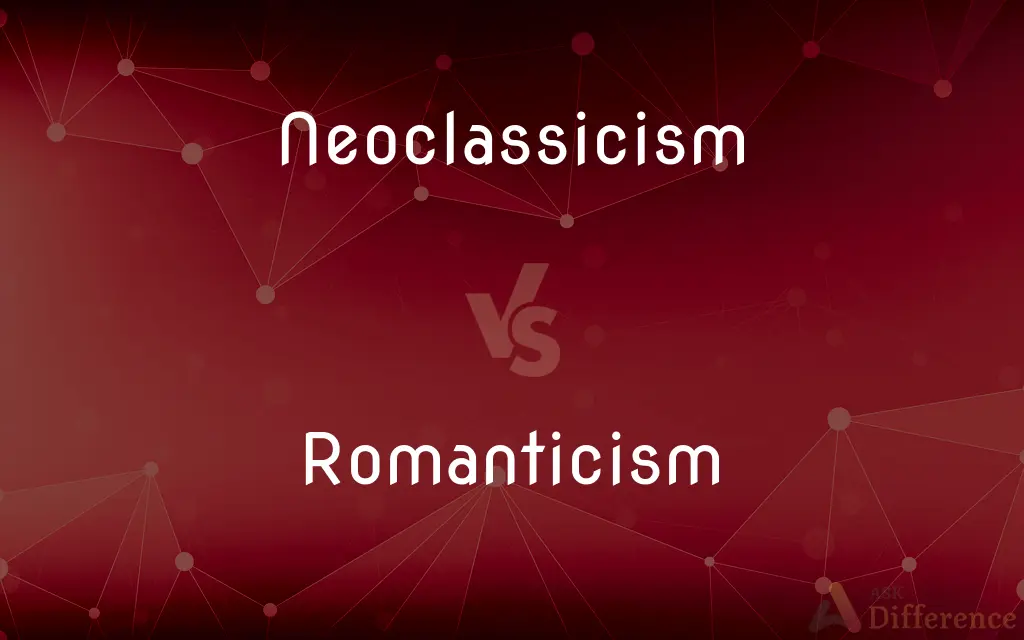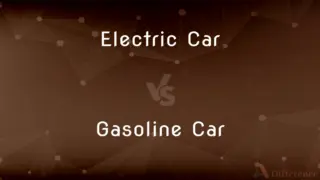Neoclassicism vs. Romanticism — What's the Difference?
By Tayyaba Rehman — Published on September 25, 2023
Neoclassicism is an art and cultural movement emphasizing order, simplicity, and symmetry, drawing inspiration from classical antiquity. Romanticism, by contrast, focuses on emotion, individualism, and nature, often challenging societal norms.

Difference Between Neoclassicism and Romanticism
Table of Contents
ADVERTISEMENT
Key Differences
Neoclassicism is an artistic and intellectual movement rooted in an admiration for the art and literature of ancient Greece and Rome. It emphasizes rationality, order, and formal discipline. Romanticism, however, emerged as a counter-movement that focuses on emotional depth, individual freedom, and the sublime in nature.
In Neoclassicism, the adherence to established norms and classical models is evident. Works in this style often showcase heroism, moral integrity, and idealized forms. On the flip side, Romanticism often defies norms, focusing on individual subjectivity and the emotional aspects of human experience, sometimes even the darker ones.
From a grammatical perspective, both "Neoclassicism" and "Romanticism" are proper nouns referring to specific cultural and artistic movements. "Neoclassicism" tends to be used to describe art, architecture, and literature, while "Romanticism" extends to these and often includes music.
In terms of influence, Neoclassicism is seen as preserving and promoting the lessons of the past. It's often associated with a structured society and governmental systems. Romanticism, on the other hand, often challenges the status quo and questions the benefit of civilization, sometimes even advocating for a return to nature.
Neoclassicism typically sees emotion and reason as being in conflict, advocating for the latter. Romanticism, conversely, often views emotion and intuition as valid, if not superior, forms of understanding and experiencing the world.
ADVERTISEMENT
Comparison Chart
Focus
Order, Symmetry, Rationality
Emotion, Individualism, Nature
Art Forms
Art, Architecture, Literature
Art, Literature, Music
Grammatical Usage
Proper Noun
Proper Noun
Cultural Impact
Preservative, Structured Society
Revolutionary, Challenging Norms
Attitude Toward Emotion
Controlled, Secondary
Central, Primary
Compare with Definitions
Neoclassicism
An artistic movement inspired by classical antiquity.
Neoclassicism in architecture often features columns and symmetry.
Romanticism
A style emphasizing individual experience.
The Romanticism of the novel lay in its deep emotional content.
Neoclassicism
A revival of classical principles.
Neoclassicism in sculpture sought to emulate Greek ideals.
Romanticism
An artistic and cultural movement focusing on emotion and nature.
Romanticism found beauty in untamed landscapes.
Neoclassicism
A cultural trend focusing on rationality and order.
Neoclassicism valued the reasoned debate of Enlightenment philosophy.
Romanticism
A challenge to established norms and conventions.
The Romanticism of the music broke from traditional forms.
Neoclassicism
A style characterized by geometric simplicity.
The painting’s Neoclassicism was evident in its structured composition.
Romanticism
An interest in the sublime and the fantastical.
Romanticism often explores themes of heroism and the supernatural.
Neoclassicism
An emphasis on traditional forms in art and literature.
Neoclassicism in literature revered the epic form.
Romanticism
A celebration of intuition over reason.
The Romanticism of the poem favored feeling over logic.
Neoclassicism
Neoclassicism (also spelled Neo-classicism; from Greek νέος nèos, "new" and Greek κλασικός klasikόs, "of the highest rank") was a Western cultural movement in the decorative and visual arts, literature, theatre, music, and architecture that drew inspiration from the art and culture of classical antiquity. Neoclassicism was born in Rome largely thanks to the writings of Johann Joachim Winckelmann, at the time of the rediscovery of Pompeii and Herculaneum, but its popularity spread all over Europe as a generation of European art students finished their Grand Tour and returned from Italy to their home countries with newly rediscovered Greco-Roman ideals.
Romanticism
An exciting and mysterious quality (as of a heroic time or adventure)
Neoclassicism
A revival in literature in the late 1600s and 1700s, characterized by a regard for the classical ideals of reason, form, and restraint.
Romanticism
Romanticism (also known as the Romantic era) was an artistic, literary, musical, and intellectual movement that originated in Europe towards the end of the 18th century, and in most areas was at its peak in the approximate period from 1800 to 1850. Romanticism was characterized by its emphasis on emotion and individualism as well as glorification of all the past and nature, preferring the medieval rather than the classical.
Neoclassicism
A revival in the 1700s and 1800s in architecture and art, especially in the decorative arts, characterized by order, symmetry, and simplicity of style.
Romanticism
Often Romanticism An artistic and intellectual movement originating in Europe in the late 1700s and characterized by a heightened interest in nature, emphasis on the individual's expression of emotion and imagination, departure from the attitudes and forms of classicism, and rebellion against established social rules and conventions.
Neoclassicism
A movement in music lasting roughly from 1915 to 1940 that sought to avoid subjective emotionalism and to return to the style of the pre-Romantic composers.
Romanticism
Romantic quality or spirit in thought, expression, or action.
Neoclassicism
Any of various intellectual movements that embrace a set of traditional principles regarded as fundamental or authoritative.
Romanticism
A romantic quality, spirit or action.
Neoclassicism
Any of several movements in the arts, architecture, literature and music that revived forms from earlier centuries.
Romanticism
A fondness for romantic characteristics or peculiarities; specifically, in modern literature, an aiming at romantic effects; - applied to the productions of a school of writers who sought to revive certain medi val forms and methods in opposition to the so-called classical style.
He [Lessing] may be said to have begun the revolt from pseudo-classicism in poetry, and to have been thus unconsciously the founder of romanticism.
Neoclassicism
A revival of the classical Greek and Roman style in art or literature.
Romanticism
Impractical romantic ideals and attitudes
Neoclassicism
Revival of a classical style (in art or literature or architecture or music) but from a new perspective or with a new motivation
Romanticism
A movement in literature and art during the late 18th and early 19th centuries that celebrated nature rather than civilization;
Romanticism valued imagination and emotion over rationality
Common Curiosities
When did Neoclassicism occur?
Neoclassicism was prominent in the 18th and early 19th centuries.
What does Neoclassicism value most?
Neoclassicism values order, symmetry, and rational thought.
When did Romanticism occur?
Romanticism was most influential in the late 18th and early 19th centuries.
Does Romanticism include music?
Yes, Romanticism had a significant impact on music.
Can Neoclassicism be emotional?
While not its focus, emotion can be present but is controlled in Neoclassicism.
What's a key feature of Romantic art?
Romantic art often depicts dramatic landscapes or emotive subjects.
Is Neoclassicism conservative?
It often is, valuing traditional forms and structures.
What is Neoclassicism?
Neoclassicism is an artistic movement inspired by classical antiquity, focusing on order and rationality.
What is Romanticism?
Romanticism is an artistic movement emphasizing emotion, individualism, and nature.
Is Neoclassicism only about visual arts?
No, Neoclassicism extends to architecture, literature, and even philosophy.
What does Romanticism value most?
Romanticism values emotion, individual experience, and the sublime in nature.
What's a key feature of Neoclassical art?
Neoclassical art often features heroic subjects and classical themes.
Is Romanticism revolutionary?
Often, yes—Romanticism frequently challenges established norms and systems.
Is Romanticism always emotional?
Generally, yes—emotion is central to the Romantic ethos.
Do both movements have literary impact?
Yes, both Neoclassicism and Romanticism influenced literature significantly.
Share Your Discovery

Previous Comparison
Electric Car vs. Gasoline Car
Next Comparison
Adverb vs. AdverbialAuthor Spotlight
Written by
Tayyaba RehmanTayyaba Rehman is a distinguished writer, currently serving as a primary contributor to askdifference.com. As a researcher in semantics and etymology, Tayyaba's passion for the complexity of languages and their distinctions has found a perfect home on the platform. Tayyaba delves into the intricacies of language, distinguishing between commonly confused words and phrases, thereby providing clarity for readers worldwide.












































